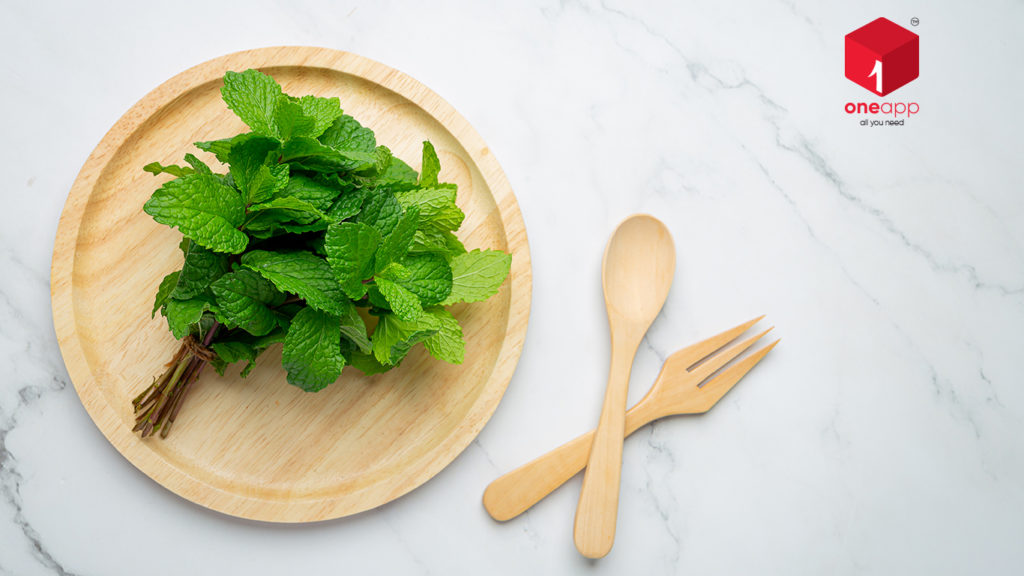Mint is an aromatic herb produced by various species of the mint plant (Mentha). Native to the eastern Mediterranean, mint gets its name from a mythic nymph named Minthe (Minto). Jealous Persephone turned her into a lowly mint plant after she had an affair with Pluto, the god of the underworld. The mint plant is common and a favourite of many gardeners, so it’s easy to grow your own. As a herb, it is gluten-free and suitable for vegan, vegetarian, and paleo diets.
TYPES OF MINT
There are over 600 types of mint plants, which include pineapple mint, apple mint, orange mint, water mint and horsemint. However, when we talk about mint, we refer to two specific types: spearmint and peppermint.
- Spearmint or curly mint are the varieties most often grown to use as a herb in cooking and beverages. Spearmint is known as the savoury mint, it’s the one we primarily use as a spice when cooking.
- Peppermint is a little too strong to use fresh for most culinary purposes. Instead, it is grown and processed into peppermint oil, which is then used as a flavouring, and it can be further refined into a menthol. Peppermint is known as the sweet mint, it’s the one you’ll find in candy, gum, teas, jellies, syrups, ice cream and other confections.
- We can find other varieties of mint that have interesting flavours and aromas. Apple mint has an apple scent; orange mint has a citrus flavour; chocolate mint has a bit of chocolate taste.
Mint tastes sweet and produces a lingering cool effect on the tongue. Peppermint has a stronger flavour with a more menthol taste. The fresh leaves have the most flavour and scent, with those much reduced in dried mint leaves.
USES OF MINT
Fresh mint leaves are usually added to recipes. A stalk with a few tender leaves is placed in a hot or cold beverage and maybe crushed (muddled) to release more flavour. Dried mint leaves can be added to a sauce or stew as it simmers. Mint extract is used to give mint flavour baked goods or confections or to flavour hot chocolate. We can use mint in teas, desserts, cocktails, sauces, body products, toothpaste and more.
Mint features many Indian chutneys and the yoghurt-based sauce raita. Indians favour pairing mint with other pungent spices such as chilies, coconut and green mango. In Malaysia, mint is used in combination with galangal and other fragrant spices for laksa, a spicy noodle dish.
When it comes to cocktails, fresh mint shines in mojitos and mint juleps.
HEALTH BENEFITS OF MINT
Each variety of mint has been traditionally used to treat numerous ailments, ranging from an upset stomach to nervousness. Modern medical research has focused on peppermint oil, which is now often sold as a dietary supplement capsule, medicinal tea, or topical preparation.
Many researchers note that peppermint oil may be of use for symptoms of irritable bowel syndrome (IBS) when taken in enteric-coated capsules. In combination with caraway oil, it may help indigestion. Topical use of peppermint oil has some limited evidence of being helpful for tension headaches. The usual doses of peppermint oil capsules should be safe, but they can be toxic in excessive doses. Peppermint oil should not be applied to children or infants as it can cause serious respiratory side effects. It can also result in rashes and skin irritation for adults as well.
Since ancient times, mint has been used to treat digestive and respiratory troubles. In recent times, researchers have found other health benefits of mint, especially in women. Peppermint tea has been shown to lower testosterone levels in females with polycystic ovarian syndrome. It has also been shown to prevent nipple pain and damage in breastfeeding mothers according to studies cited in recent books and journals. Include mint twice a week in your diet and improve your health keeping digestive and respiratory illness at bay.
You can buy fresh Mint and other herbs and vegetables easily now with oneapp. oneapp lists your local grocery store and vegetable vendors and allows you to purchase from your trusted neighbourhood store but without the need to step out from the home. Download oneapp now.
MAKE YOUR OWN DRIED MINT
We can dry fresh mint, whether from our garden or bought in bunches at a farmers market. To make a dried mint, we need to simply cut long sprigs of mint, tie them into bundles, and hang them upside down. Once dry, remove the leaves and store them in a glass jar or sealed plastic bag and enjoy year-round.
MINT YOGURT CHUTNEY
Let’s learn a quick Mint Yogurt Chutney, quite famous in Indian households all around the year. Mint Yogurt Chutney or Pudina Dahi chutney is a refreshing and quick chutney made using garden-fresh mint and yoghurt. This chutney goes well with kabobs, tikkas, chaats as well as spreads on sandwiches and parathas and serves as a great condiment in get-togethers and parties.
Ingredients:
- 1 cup Fresh Mint Leaves
- 1/4 Cup Yogurt/Curd
- 2-3 Green Chillies
- Black salt to taste (Use less, as there would be some sourness from Yogurt/Curd
- 1 teaspoon Cumin Seeds
- 1/4 teaspoon sugar
Preparation:
- Wash the mint leaves thoroughly in clean tap water
- Drain and add it into a blender jar.
- Add the remaining ingredients and blend until smooth.
- Add water only if required a tablespoon at a time.
- One can adjust the salt or Yogurt/Curd as per taste
All you need is your blender and the ingredients to make this delicious dip cum chutney.
Enjoy mint in your dressings, mocktails and recipes and get refreshed with its fresh taste and aroma.

